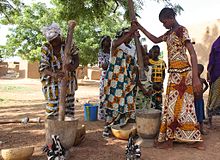
Back Afrikanische Waxprints German Wax (tissu) French African wax prints IG Wax (abbigliamento) Italian アフリカン・ワックス・プリント Japanese Afrikaanse wasdruk Dutch Ankara (material) Portuguese
This article includes a list of general references, but it lacks sufficient corresponding inline citations. (November 2013) |




African wax prints, Dutch wax prints[1][2] or Ankara,[3] are a type of common material for clothing in West Africa and Central Africa. They were introduced to West and Central Africans by Dutch merchants during the 19th century, who took inspiration from native Indonesian designs.[4] They began to adapt their designs and colours to suit the tastes of the African market. They are industrially produced colourful cotton cloths with batik-inspired printing.[5] One feature of these materials is the lack of difference in the colour intensity of the front and back sides. The wax fabric can be sorted into categories of quality due to the processes of manufacturing. The term "Ankara" originates from the Hausa name for Accra, the capital of what is now Ghana. Initially used by Nigerian Hausa tradesmen, it was meant to refer to "Accra," which served as a hub for African prints in the 19th century.[6]
Normally, the fabrics are sold in lengths of 12 yards (11 m) as "full piece" or 6 yards (5.5 m) as "half piece". The colours comply with local preferences of the customers. Typically, clothing for celebrations is made from this fabric.
Wax prints are a type of nonverbal communication among African women, and thereby carry their messages out into the world.[citation needed] Some wax prints are named after personalities, cities, buildings, sayings, or occasions. The producer, name of the product, and registration number of the design is printed on the selvage, thus protecting the design and attesting to the quality of the fabric. Wax fabrics constitute capital goods for African women. They are therefore often retained based on their perceived market value.
In Sub-Saharan Africa these textiles had an annual sales volume in 2016 of 2.1 billion yards, with an average production cost of $2.6 billion and retail value of $4 billion.[7]
Ghana has an annual consumption of textiles of about 130 million yards (120 million metres). The three largest local manufacturers, Akosombo Textiles Limited (ATL), Ghana Textiles Print (GTP), and Printex, produce 30 million yards, while 100 million yards come from inexpensive smuggled Asian imports.[8]
The Vlisco Group, owner of the Vlisco, Uniwax, Woodin, and GTP brands, produced 58.8 million yards (53.8 million meters) of fabric in 2011. Net sales were €225 million, or $291.65 million.[9] In 2014, Vlisco's 70 million yards of fabric (about 64 million meters) were produced in the Netherlands, yielding a turnover of €300 million.[10]


- ^ Sylvanus, Nina (29 August 2016). "West Africans ditch Dutch wax prints for Chinese 'real-fakes'". The Conversation. Retrieved 19 November 2021.
- ^ Jones, Jonathan (16 September 2021). "'This has never been so much fun!': Royal Academy Summer Exhibition review". The Guardian. Retrieved 19 November 2021.
- ^ "900+ Ankara ideas in 2022 | african clothing, african fashion dresses, african dress". Pinterest. Retrieved 9 June 2022.
- ^ "A PIECE OF HISTORY- THE AKWETE FABRIC". Guardian. Nigeria. 5 December 2016. Retrieved 5 December 2016.
- ^ Gerlich 2004, p. 1.
- ^ Things To Consider Before Buying African Ankara Print Fabrics, Clothing, Headwraps and more, Afrothreads, retrieved 21 December 2023
- ^ Aibueku, Uyi (16 February 2016). "In textile industry, a hidden goldmine". The Guardian. Nigeria. Retrieved 20 May 2018.
- ^ "Textile industry needs attention to boost local manufacturing". My Joy Online. 19 September 2017. Archived from the original on 19 September 2017. Retrieved 20 May 2018.
- ^ Young, Robb (15 November 2012). "Africa's Fabric Is Dutch". The New York Times. Retrieved 20 May 2018.
- ^ "Wax prints, like Vlisco, are still making believe that they are African". Yen.com.gh. Archived from the original on 7 May 2019. Retrieved 20 May 2018.